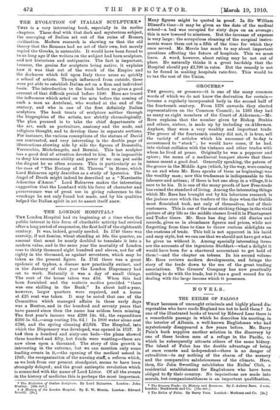THE EVOLUTION OF ITALIAN SCULPTURE.* Tors is a very interesting
book, especially in its earlier chapters. These deal with that dark and mysterious subject, the emerging of Italian art out of the ruins of Roman civilisation. Modern research is showing us that the old theory that the Romans had no art of their own, but merely copied the Greeks, is untenable. It would have been found to be so long ago if the writers on the subject had been sculptors, and not historians and antiquaries. The fact is important, because, the genius for sculpture being native, it explains how it was that out of the wreck of the Empire and the darkness which fell upon Italy there arose so quickly a school of artists. Though influenced from outside, these were yet able to establish Italian art on a firm and individual basis. The introduction to the book before us gives a good account of that difficult period before 1100. Here are traced the influences which acted on the arts before the coming of such a man as Antelami, who worked at the end of the century, and who is one of the first definitely Italian sculptors. The book treats of sculpture neither through the biographies of the artists, nor strictly chronologically. The plan pursued is to take the chief departments of the art, such as portraiture, anatomy and the nude, and religious thought, and to develop these in separate sections. For instance, the various conceptions of the statues of David are contrasted, and very interesting is the double page of illustrations showing side by side the figures of Donatello, Verrocchio, Michelangelo, and Bernini. This last sculptor has a good deal of attention devoted to him. It is impossible to deny his enormous ability and power if we can put aside the disgust he so often arouses. This is particularly ao in the case of "The Ecstasy of St. Theresa" in Rome, which Lord Balcarres aptly describes as a study of hysterics. The Angel of Death might indeed be described as a " Narcisetto Adoncino d'Amor." Lord Balcarres makes the interesting suggestion that the Lombard with his force of character and perseverance was of great use in giving coherence to the wreckage be not only found but made, and by his qualities helped the Italian spirit in art to assert itself anew.










































 Previous page
Previous page